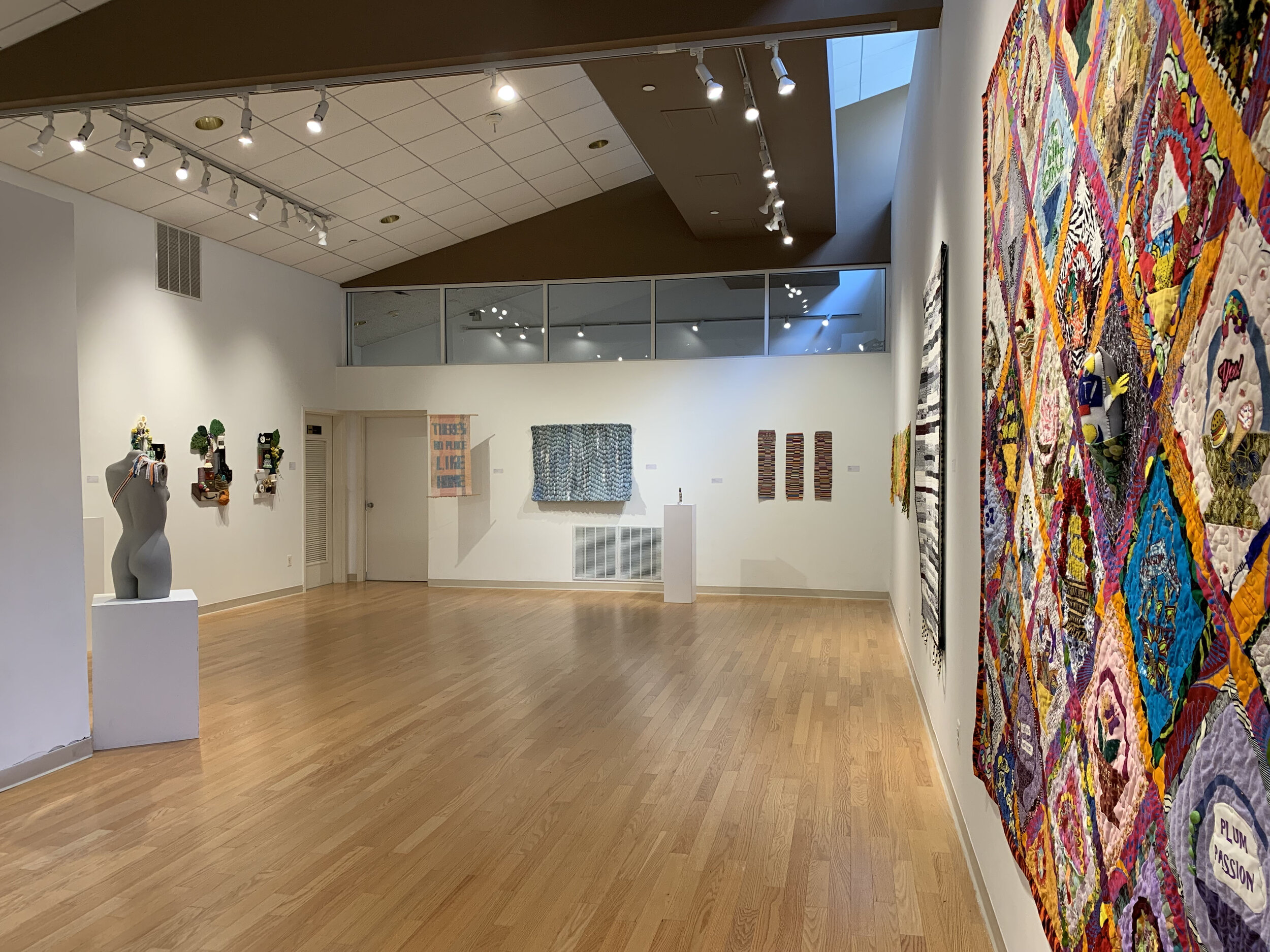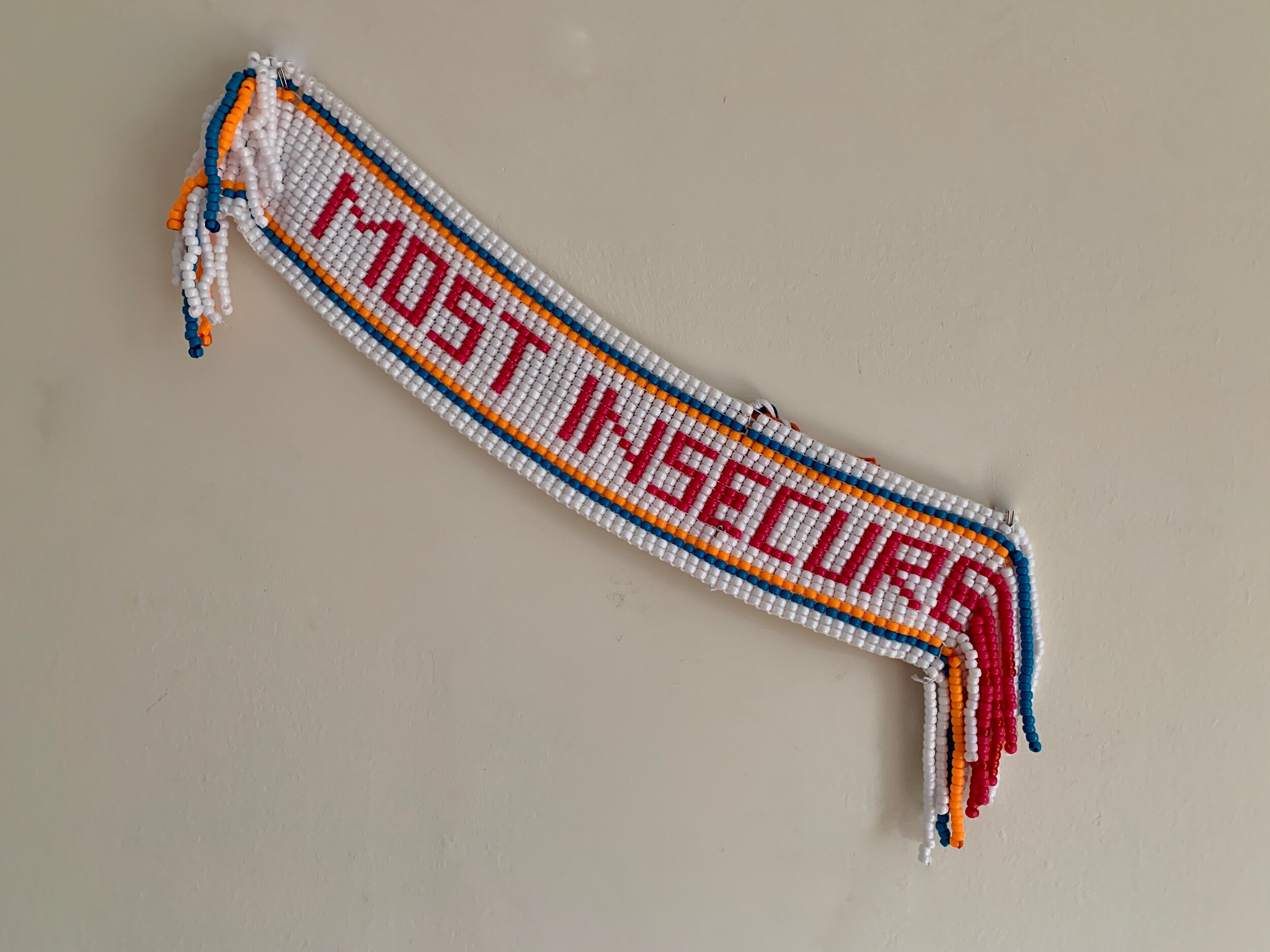
Keeping it Together: Local Fiber Arts in the Time of COVID
August 31 - September 30, 2021
Keeping it Together: Local Fiber Arts in the Time of COVID
How many of us during the last year and a half have felt as though we were just barely keeping it together—barely holding all the strands of our lives in place as they were suddenly disrupted by a terrifying and invisible threat. Fiber and textiles have played a powerful role in helping many of us to keep it together this year, though we might not have noticed. Fiber optic cables have kept us connected to our friends, families, jobs, teachers, and students when we couldn’t share space. Cloth face masks, or those made from nonwoven fibers have protected us from the virus. Cotton t-shirts and fabric banners have carried messages of protest and opposition to racism and injustice. Many of us found solace from feelings of anxiety in the repetitive motions and creative expressions of stitching, knitting, crocheting, weaving, macrame, quilting, embroidery, or other crafts which transform fibers into useful, beautiful, and comforting objects.
The artists represented in this exhibition all use fiber to reflect in one way or another on what life has looked like during this very strange and unfamiliar time. Some of their work reflects on place and displacement. Others use fiber to draw our attention to the everyday things that we perhaps have started to notice more as our daily experiences got geographically smaller. Many of these artists use fiber to connect with traditional techniques and family histories, grounding themselves in the past. They use fiber as a space for exploring personal stories and their connections to a broader historical narrative.
Elaine Zukowski’s work was partly inspired by her mother’s beaded bracelets and partly by tatting, a technique for making lace based on knot tying developed by sailors and fishermen. She celebrates humble knots by rendering them in luminous glass beads. Shirey Baig also explores the mindful tying of simple knots in the form of macrame to create extraordinarily complex and beautiful objects. These repetitive meditations on material called to my mind the ways that the routine of our days staying at home seems to repeat over and over. That repetition is also reflected in the quotidian plastic sleeves protecting the daily newspaper woven through chicken wire by Marsha Salzberg in Le Mer. The daily ritual of picking up and unwrapping the paper, weaving together one day after another. Yunkyoung Cho’s still-lives based on the historic Korean genre of Chaekgeori paintings uses everyday objects, beautifully constructed from fiber, to reference our daily routines, including some that have become more familiar during the pandemic. Sylv Litz comments on similar pandemic rituals in her work Phone, key, wallet... mask, also pointing to the waste produced by these now essential accessories.
Like Martínez and Salzberg, many of the artists in this exhibition use materials that might have otherwise gone to waste. Rosalind Robinson’s Edge of Reality—whose title seems to reflect the mood of 2020—is a Second Generation Quilt, meaning it is made from scraps produced by a First Generation Quilt. Noelani Jones also reuses scraps in her weavings, alongside natural dyes. She describes her process of weaving the text “There’s No Place Like Home” freehand as reflecting the uncertainty of this moment, as she says, “taking it day by day, thread by thread.”
In addition to the meditative and calming qualities of working with fiber as a medium, many of the artists in this exhibition considered the ways that fiber can connect us to each other. Unlike other artistic materials, fiber is an integral part of our everyday lives, it’s in the sheets we wake up in, the clothes we put on, the towels in our bathrooms, the seats of the bus or car we ride in, the carpet we walk on, all around us. This is a material that is humble and familiar, but also full of meaning and sentiment.
The MICA Raffle Quilt Group used quilts, a very familiar, comforting, and homey object for many of us, as a way to stay connected from afar during the pandemic. Once the members were geographically scattered all over the US, they began to work together over Zoom, sending fabric to each other and completed squares to Susie Brandt for finishing. This group of students, alumni, faculty, staff, and community members, under the mentorship of Glenda Richardson and Rosalind Robinson and other members of the African American Quilters of Baltimore, has created 9 quilts over the course of the pandemic. Some have been raffled to raise funds to support African American and students of color at MICA. As with so many quilts, their collaborative Gift Basket Quilt, has a message stitched into each individual square.
Alec Judelson and Sasha Baskin also tell stories in their work, drawing on one of the most ancient uses of weaving. Judelson’s Most Insecure reflects on his feelings in a recent relationship with bittersweet comedy. In The Martyr (Here for the Right Reasons), Baskin weaves a still from the reality TV show The Bachelor, reflecting on one of the most powerful sources of modern mythology regarding straight courtship and romantic love. Catherine Rupan Mapp’s work is also informed by popular culture including electronic music, neon signs, and blacklight images. Influenced by her Indo-Caribbean, Cuban and Indigenous Mexican heritage, she brings various forms of meditative experiences together in her weaving, Miami Sunrise.
Annika Cheng explores Sino-diaspora identity by taking iconic and much appropriated symbols of Chinese-ness in the US, Mahjong tiles and the Cheong Sam, and reinterpreting them to explore the complexities of growing up in America. Her work asks the viewer to grapple with the ways that China has been exoticized and stereotyped in the US and how that representation impacts the lived experience of Chinese Americans. This work is particularly potent in the wake of the escalation of anti-Asian racism and violence during the Covid-19 pandemic. Susie Brandt’s triptych of weavings, Arm 1 (HERE), Arm 2 (FIST), and Arm 3 (VACCINE), through simple gestures woven in colorful cotton, call to mind hands reaching out for help or connection, protesting, and celebrating the protection of vaccines.
All of the work in this exhibition gives us, as viewers, a chance to reflect on how life has changed since March of 2020. How have we experienced the world differently? Perhaps we felt overwhelmed, or perhaps made space to slow down. Perhaps we began to see the world in a different way, certain things that were always there came to the surface in a new way. Many of us examined the textures of our daily lives from a different perspective. The work of these artists give us a space to consider how fiber can connect the personal, local, and domestic to the public, global, and political.
~Victoria Rose Pass
Exhibition Juror
Rosalind Robinson, 'Edge of Reality,' Quilt, 2019
Noelani Jones, 'There's No Place Like Home,' Handwoven and naturally died fiber, 2020
MICA Raffle Quilt Group, 'Gift Basket Quilt,' Hand and machine stitched fabric, 2021
Sasha Baskin, 'The Martyr' (Here for the Right Reasons), Filet lace, fishing net, cotton thread, Screenshot from "The Bachelor" (Season 22), 2019
Alec Judelson, 'Most Insecure,' Pony beads, cotton thread, 2021
Catherine Rupan Mapp, 'Miami Sunrise,' Hand painted cotton yarn, neon embroidery thread, 2020
Annika Cheng, 'Mahjong Tiles,' Acrylic yarn, 2020
Susie Brandt, (left to right), 'Arm 1 (HERE),' 2020; 'Arm 2 (FIST),' 2020; 'Arm 3 (VACCINE),' 2021, Hand woven cotton
About the Juror
Victoria Rose Pass
Victoria Rose Pass is an Associate Professor at the Maryland Institute College of Art and a specialist in Visual Culture, particularly in areas of design and fashion. Her essay "Racial Masquerades in the Magazines: Defining White Femininity Between the Wars," as published in the Journal of Modern Periodical Studies. Her co-edited the book Design Beyond the Canon with Jennifer Kauffman-Buhler and Christopher Wilson was published by Bloomsbury in February 2019. She also co-edited the volume, Women's Magazines in Print and New Media with Noliwe Rooks and Ayana Weekley, which was published by Routledge in 2016. Her essay "Schiaparelli's Convulsive Gloves" was published in 2015 in Extravagances, the final volume of the Habits of Being series from the University of Minnesota. Her writing has also appeared in Fashion, Style & Popular Culture, Omenka Magazine, Design and Culture, caa.reviews, and BmoreArt. She received her BA in Art History from Boston University, her MA in Art History from the Art Institute of Chicago, and her PhD in Visual and Cultural Studies from the University of Rochester.













